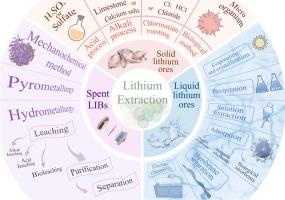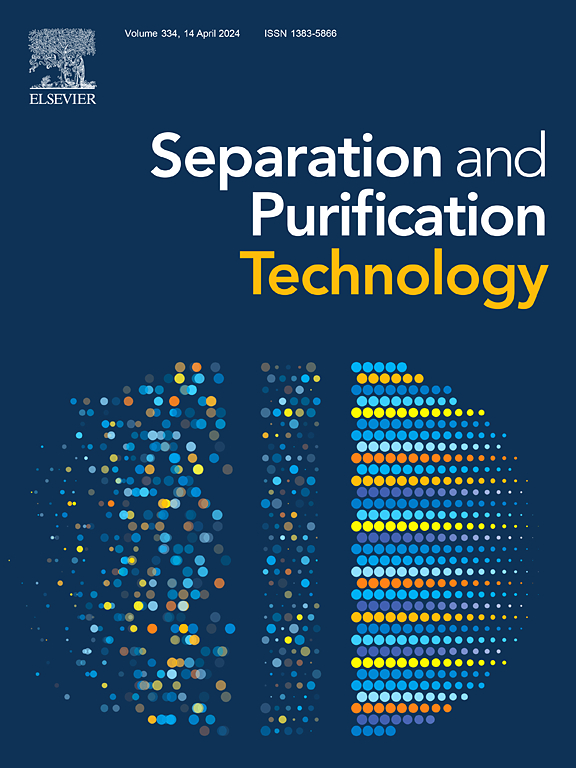Research progress of technology of lithium extraction
IF 8.1
1区 工程技术
Q1 ENGINEERING, CHEMICAL
引用次数: 0
Abstract
Lithium (Li) is a core strategic metal in the new energy industry. Due to its wide range of applications in various fields, the demand from the resource market is growing year by year. At present, Li is mostly extracted from lithium minerals (solid lithium ore and liquid lithium ore), seawater and spent lithium-ion batteries (LIBs). This paper focuses on the lithium extraction process of various lithium resources, expounds its reaction mechanism and application performance, and puts forward the possible future development direction. The extraction of lithium from solid lithium ores by the acid process has good practical applications but poor environmental sustainability. Additionally, the proportion of lithium resources of liquid lithium ore (brine) is greater than that of solid lithium ore, and extracting lithium from brine is the most valuable choice at present. The Li content in the brine is typically low. Lithium extraction with inorganic adsorbent is the most advanced method at present. Different techniques include evaporative crystallization, precipitation, solvent extraction, adsorption with organic and biological adsorbent, membrane separation, and electrochemical methods. However, most of the technologies with favorable economic benefits and high efficiency are still difficult to achieve large-scale industrialization. Therefore, it is still a great challenge to develop an economical, environmentally friendly, efficient and practical technology for extracting lithium from brine. Furthermore, with the rise and vigorous development of the LIBs market, the treatment and recycling of spent LIBs has become a major problem. According to the research, it is feasible to extract lithium from spent LIBs and achieve industrialization and recycling. Therefore, research on lithium extraction from spent LIBs is also the key to increasing the supply of lithium resources and achieving resource recycling.

锂提取技术的研究进展
锂(Li)是新能源产业的核心战略金属。由于其在各个领域的广泛应用,资源市场的需求逐年增长。目前,锂主要从锂矿物(固体锂矿和液体锂矿)、海水和废旧锂离子电池(LIBs)中提取。本文重点介绍了各种锂资源的提锂工艺,阐述了其反应机理和应用性能,并提出了未来可能的发展方向。通过酸法工艺从固体锂矿石中提取锂具有良好的实际应用价值,但环境可持续性较差。此外,液态锂矿(卤水)的锂资源比例大于固态锂矿,从卤水中提取锂是目前最有价值的选择。卤水中的锂含量通常较低。使用无机吸附剂提取锂是目前最先进的方法。不同的技术包括蒸发结晶法、沉淀法、溶剂萃取法、有机和生物吸附剂吸附法、膜分离法和电化学法。然而,大多数经济效益好、效率高的技术仍难以实现大规模产业化。因此,开发一种经济、环保、高效、实用的卤水提锂技术仍是一项巨大的挑战。此外,随着锂电池市场的兴起和蓬勃发展,废锂电池的处理和回收已成为一大难题。研究表明,从废锂电池中提取锂并实现产业化和循环利用是可行的。因此,从废锂电池中提取锂的研究也是增加锂资源供给、实现资源循环利用的关键。
本文章由计算机程序翻译,如有差异,请以英文原文为准。
求助全文
约1分钟内获得全文
求助全文
来源期刊

Separation and Purification Technology
工程技术-工程:化工
CiteScore
14.00
自引率
12.80%
发文量
2347
审稿时长
43 days
期刊介绍:
Separation and Purification Technology is a premier journal committed to sharing innovative methods for separation and purification in chemical and environmental engineering, encompassing both homogeneous solutions and heterogeneous mixtures. Our scope includes the separation and/or purification of liquids, vapors, and gases, as well as carbon capture and separation techniques. However, it's important to note that methods solely intended for analytical purposes are not within the scope of the journal. Additionally, disciplines such as soil science, polymer science, and metallurgy fall outside the purview of Separation and Purification Technology. Join us in advancing the field of separation and purification methods for sustainable solutions in chemical and environmental engineering.
 求助内容:
求助内容: 应助结果提醒方式:
应助结果提醒方式:


